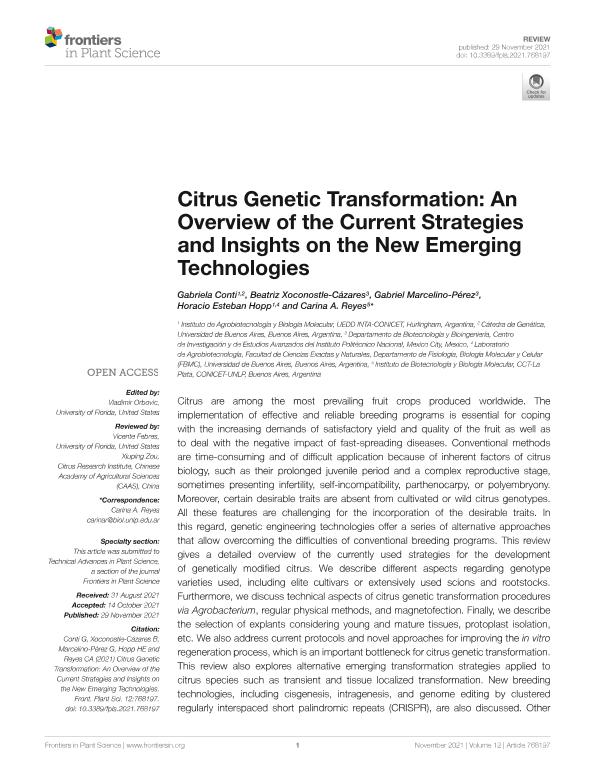Mostrar el registro sencillo del ítem
dc.contributor.author
Conti, Gabriela

dc.contributor.author
Xoconostle Cázares, Beatriz
dc.contributor.author
Marcelino Pérez, Gabriel
dc.contributor.author
Hopp, Horacio Esteban

dc.contributor.author
Reyes Martinez, Carina Andrea

dc.date.available
2023-01-23T17:44:06Z
dc.date.issued
2021-11
dc.identifier.citation
Conti, Gabriela; Xoconostle Cázares, Beatriz; Marcelino Pérez, Gabriel; Hopp, Horacio Esteban; Reyes Martinez, Carina Andrea; Citrus Genetic Transformation: An Overview of the Current Strategies and Insights on the New Emerging Technologies; Frontiers Media; Frontiers in Plant Science; 12; 11-2021; 1-22
dc.identifier.issn
1664-462X
dc.identifier.uri
http://hdl.handle.net/11336/185316
dc.description.abstract
Citrus are among the most prevailing fruit crops produced worldwide. The implementation of effective and reliable breeding programs is essential for coping with the increasing demands of satisfactory yield and quality of the fruit as well as to deal with the negative impact of fast-spreading diseases. Conventional methods are time-consuming and of difficult application because of inherent factors of citrus biology, such as their prolonged juvenile period and a complex reproductive stage, sometimes presenting infertility, self-incompatibility, parthenocarpy, or polyembryony. Moreover, certain desirable traits are absent from cultivated or wild citrus genotypes. All these features are challenging for the incorporation of the desirable traits. In this regard, genetic engineering technologies offer a series of alternative approaches that allow overcoming the difficulties of conventional breeding programs. This review gives a detailed overview of the currently used strategies for the development of genetically modified citrus. We describe different aspects regarding genotype varieties used, including elite cultivars or extensively used scions and rootstocks. Furthermore, we discuss technical aspects of citrus genetic transformation procedures via Agrobacterium, regular physical methods, and magnetofection. Finally, we describe the selection of explants considering young and mature tissues, protoplast isolation, etc. We also address current protocols and novel approaches for improving the in vitro regeneration process, which is an important bottleneck for citrus genetic transformation. This review also explores alternative emerging transformation strategies applied to citrus species such as transient and tissue localized transformation. New breeding technologies, including cisgenesis, intragenesis, and genome editing by clustered regularly interspaced short palindromic repeats (CRISPR), are also discussed. Other relevant aspects comprising new promoters and reporter genes, marker-free systems, and strategies for induction of early flowering, are also addressed. We provided a future perspective on the use of current and new technologies in citrus and its potential impact on regulatory processes.
dc.format
application/pdf
dc.language.iso
eng
dc.publisher
Frontiers Media

dc.rights
info:eu-repo/semantics/openAccess
dc.rights.uri
https://creativecommons.org/licenses/by/2.5/ar/
dc.subject
CISGENESIS AND INTRAGENESIS
dc.subject
CITRUS BIOTECHNOLOGY
dc.subject
CITRUS PROMOTERS
dc.subject
CITRUS TRANSGENIC PLANTS
dc.subject
CRISPR IN CITRUS
dc.subject
IN VITRO REGENERATION
dc.subject
REPORTER AND SELECTION MARKERS
dc.subject
TRANSFORMATION METHODS
dc.subject.classification
Biotecnología Agrícola y Biotecnología Alimentaria

dc.subject.classification
Biotecnología Agropecuaria

dc.subject.classification
CIENCIAS AGRÍCOLAS

dc.title
Citrus Genetic Transformation: An Overview of the Current Strategies and Insights on the New Emerging Technologies
dc.type
info:eu-repo/semantics/article
dc.type
info:ar-repo/semantics/artículo
dc.type
info:eu-repo/semantics/publishedVersion
dc.date.updated
2022-09-21T11:21:26Z
dc.journal.volume
12
dc.journal.pagination
1-22
dc.journal.pais
Suiza

dc.journal.ciudad
Lausanne
dc.description.fil
Fil: Conti, Gabriela. Instituto Nacional de Tecnología Agropecuaria. Centro de Investigación en Ciencias Veterinarias y Agronómicas. Instituto de Agrobiotecnología y Biología Molecular. Consejo Nacional de Investigaciones Científicas y Técnicas. Oficina de Coordinación Administrativa Parque Centenario. Instituto de Agrobiotecnología y Biología Molecular; Argentina
dc.description.fil
Fil: Xoconostle Cázares, Beatriz. CENTRO DE INVESTIGACIÓN Y DE ESTUDIOS AVANZADOS ; INSTITUTO POLITÉCNICO NACIONAL;
dc.description.fil
Fil: Marcelino Pérez, Gabriel. CENTRO DE INVESTIGACIÓN Y DE ESTUDIOS AVANZADOS ; INSTITUTO POLITÉCNICO NACIONAL;
dc.description.fil
Fil: Hopp, Horacio Esteban. Instituto Nacional de Tecnología Agropecuaria. Centro de Investigación en Ciencias Veterinarias y Agronómicas. Instituto de Agrobiotecnología y Biología Molecular. Consejo Nacional de Investigaciones Científicas y Técnicas. Oficina de Coordinación Administrativa Parque Centenario. Instituto de Agrobiotecnología y Biología Molecular; Argentina
dc.description.fil
Fil: Reyes Martinez, Carina Andrea. Consejo Nacional de Investigaciones Científicas y Técnicas. Centro Científico Tecnológico Conicet - La Plata. Instituto de Biotecnología y Biología Molecular. Universidad Nacional de La Plata. Facultad de Ciencias Exactas. Instituto de Biotecnología y Biología Molecular; Argentina
dc.journal.title
Frontiers in Plant Science
dc.relation.alternativeid
info:eu-repo/semantics/altIdentifier/doi/http://dx.doi.org/10.3389/fpls.2021.768197
Archivos asociados
